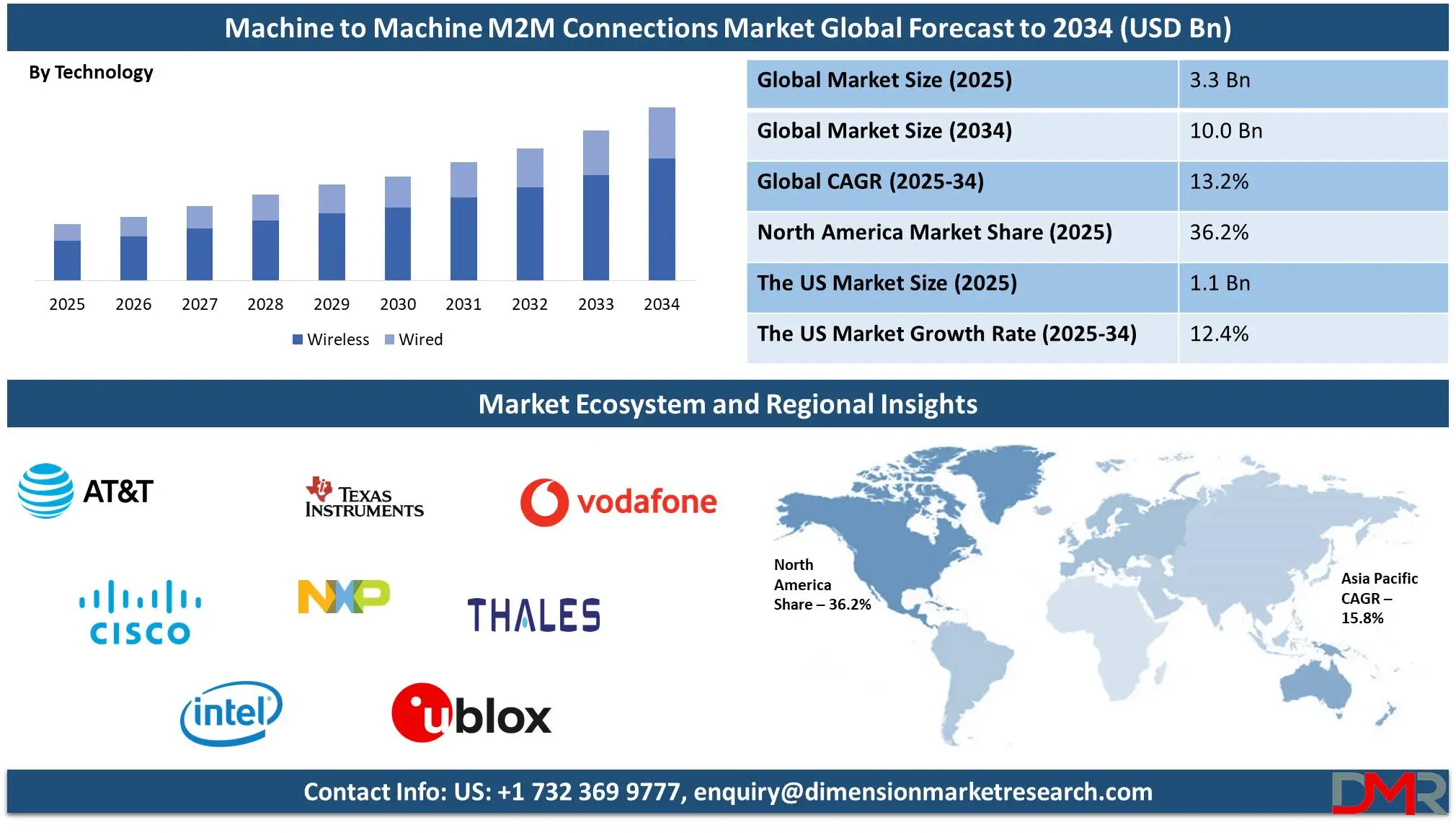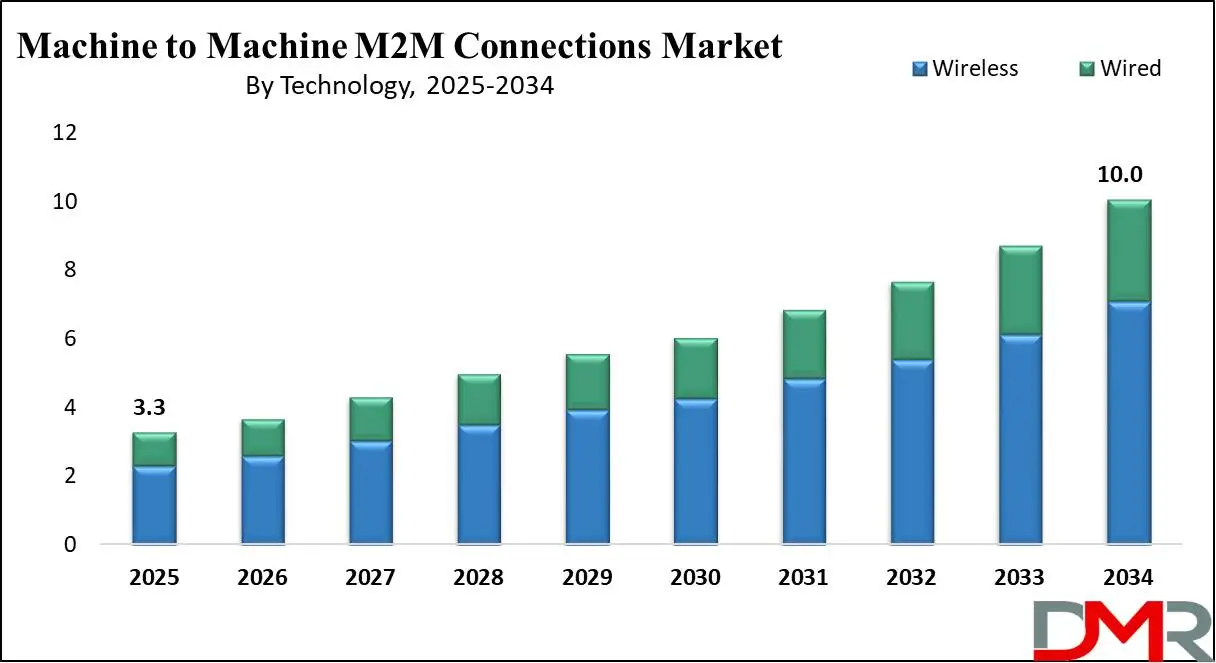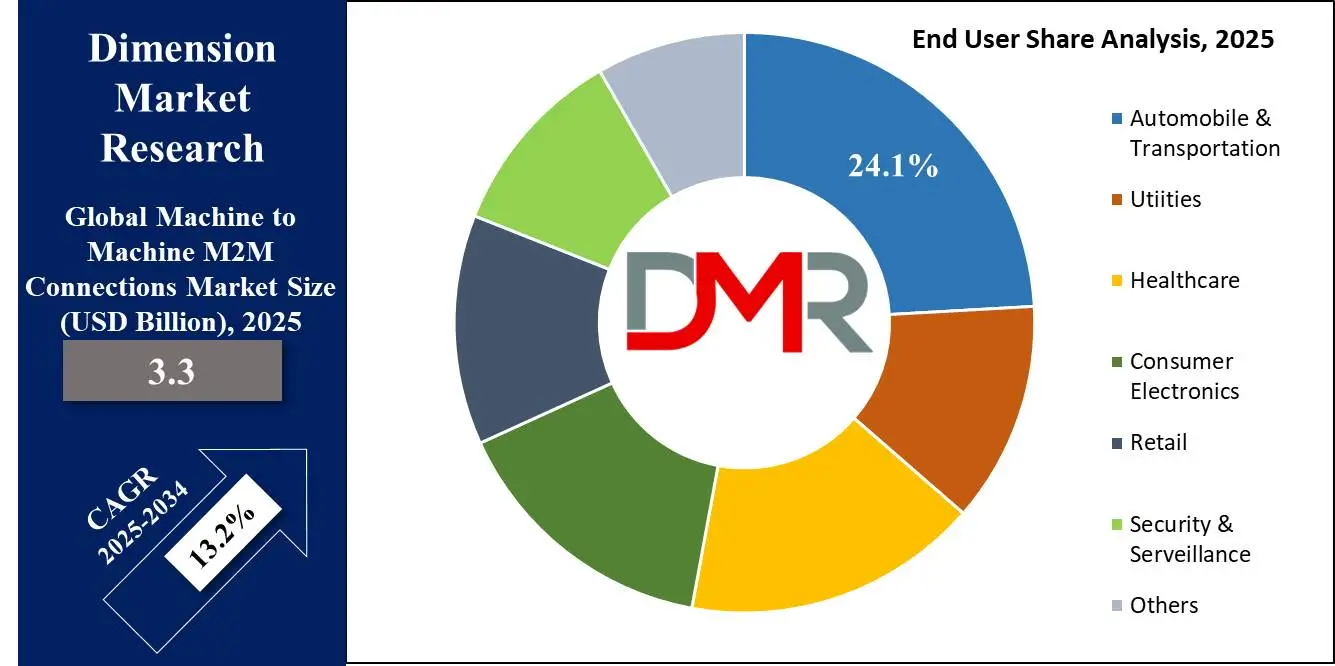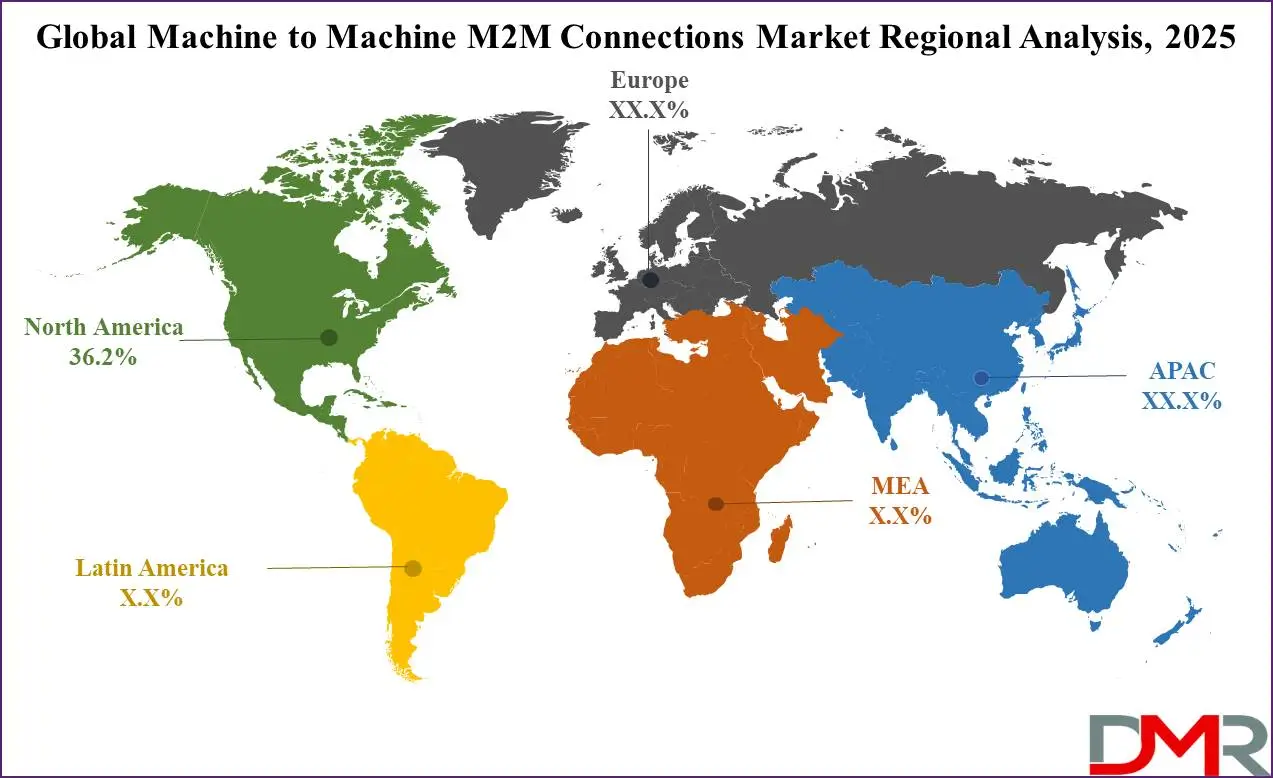Market Overview
The Global Machine to Machine M2M Connections Market is projected to reach USD 3.3 billion in 2025 and grow at a compound annual growth rate of 16.6% from there until 2034 to reach a value of USD 10.0 billion.
Machine-to-machine (M2M) connections refer to the exchange of data directly between machines without human interference, like automated meters, connected cars, industrial sensors and healthcare devices. M2M technology acts as the backbone of IoT networks like 4G/5G networks or Wi-Fi or satellite; as businesses and industries embrace automation and digital transformation, M2M connections continue to proliferate rapidly.

M2M connections have grown exponentially in demand with the expansion of smart technologies. Sectors including transportation, healthcare, manufacturing, and agriculture rely highly on M2M for efficiency and automation purposes. M2M allows remote patient monitoring through connected medical devices, improving access to healthcare services; in agriculture, it uses smart irrigation systems using M2M technology to optimize water usage, leading to higher crop yields; additionally, industries use M2M monitoring equipment performance, thus reducing maintenance costs; governments and businesses mainly invest in M2M solutions to improve productivity and resource management.
Multiple key trends are driving the expansion of M2M connections. 5G networks provide faster and more reliable connectivity for M2M applications, and embedded SIM (eSIM) technology makes the deployment of solutions worldwide much simpler. AI/
big data analytics also advance M2M systems by providing real-time data analysis capabilities and predictive maintenance features, thus increasing their adoption across various industries.
Further, major events have had a profound effect on M2M adoption. The COVID-19 pandemic triggered a greater need for remote monitoring and automation in healthcare and logistics environments, driving an upsurge in M2M usage; the global chip shortage affected production of M2M-enabled devices, causing temporary supply chain disruptions; however, governments and companies continued investing in smart infrastructure such as smart cities and automated factories, which increased M2M demand while regulatory developments, including stringent cybersecurity measures, are forming the future of M2M connections to ensure data privacy and network security for all.
As more industries adopt smart solutions, M2M connections look increasingly promising. With 5G's rollout, it will become even more efficient, allowing ultra-fast communication between devices at reduced latency levels. Companies should develop advanced IoT applications further integrating M2M into everyday life; M2M will become even more important as smart cities grow; traffic management, energy conservation, and public safety could all benefit greatly from M2M usage; however, cybersecurity risks must be carefully managed for smooth expansion to occur.

Overall, M2M connections have transformed how industries operate by improving automation, efficiency, and real-time data exchange. As businesses and governments recognize its benefits, its adoption will increase and shape the future of smart systems and connected devices globally.
The US Machine to Machine M2M Connections Market
The US Machine to Machine M2M Connections Market is projected to reach USD 1.1 billion in 2025 at a compound annual growth rate of 12.4% over its forecast period.
The US has strong growth opportunities in the Machine-to-Machine (M2M) connections market due to expanding 5G networks, smart city projects, and increasing demand for automation. The rise in the adoption of connected vehicles, industrial IoT, and remote healthcare solutions further boosts M2M growth. Government initiatives supporting digital infrastructure and cybersecurity also create opportunities for innovation and investment in M2M technology.
Further, the market is rapidly driven by advancements in 5G, industrial automation, and the growing need for smart transportation and healthcare solutions. However, challenges like high deployment costs, interoperability issues, and cybersecurity risks hinder growth. Ensuring secure and standardized M2M communication remains a key concern, as industries adopt more connected devices, increasing the need for strong data protection and regulatory compliance.
Machine to Machine M2M Connections Market: Key Takeaways
- Market Growth: The Machine to Machine M2M Connections Market size is expected to grow by 6.3 billion, at a CAGR of 13.2% during the forecasted period of 2026 to 2034.
- By Technology: The wireless segment is anticipated to get the majority share of the Machine to Machine M2M Connections Market in 2025.
- By End User: The automotive & transportation segment is expected to get the largest revenue share in 2025 in the Machine to Machine M2M Connections Market.
- Regional Insight: North America is expected to hold a 36.2% share of revenue in the Global Machine to Machine M2M Connections Market in 2025.
- Use Cases: Some of the use cases of machine-to-machine M2M Connections include smart metering & utilities, healthcare & remote monitoring, and more.
Machine to Machine M2M Connections Market: Use Cases
- Smart Metering & Utilities: M2M connections enable automated meter reading for electricity, water, and gas, allowing utility companies to monitor consumption remotely, reduce operational costs, and detect faults or leaks in real-time.
- Connected Vehicles & Fleet Management: Transportation companies use M2M for GPS tracking, vehicle diagnostics, and route optimization, improving fuel efficiency, reducing downtime, and enhancing driver safety through real-time monitoring.
- Healthcare & Remote Monitoring: M2M technology helps connect medical devices that track patients’ vital signs, enabling remote consultations, timely alerts for critical conditions, and better chronic disease management without frequent hospital visits.
- Industrial Automation & Smart Manufacturing: Factories use M2M to monitor equipment performance, predict maintenance needs, and automate production lines, minimizing downtime, improving efficiency, and minimizing human intervention in complex processes.
Stats & Facts
- According to OECD(Organization for Economic Co-operation and Development), fibre connections accounted for 42% of all fixed broadband subscriptions by the end of 2023, marking an increase from 38% a year earlier, while 5G mobile broadband subscriptions reached 28%, a 9% rise compared to the end of 2022.
- As per OECD, total fibre connections in OECD countries have surged by 73% since COVID, increasing from 122 million in December 2019 to 211 million by the end of 2023, reflecting the rapid shift toward high-speed internet infrastructure.
- OECD data shows that Korea leads in fibre broadband penetration with 89.6% of total fixed broadband subscriptions, followed closely by Iceland at 89%, Spain at 86%, Lithuania at 80%, and Japan at 79%.
- OECD highlights fibre as a crucial technology for future-proofing digital infrastructure due to its symmetrical upload and download speeds, scalability, and ability to support 5G mobile networks.
- The Communications Authority of Kenya reports an 8.4% rise in Machine-to-Machine (M2M) subscriptions, reaching 1.74 million by June 2024, which is a 10.7% increase from 1.57 million in June 2023.
- According to Tanzania Communications Regulatory Authority, total telecom subscriptions, including SIM cards and fixed lines (both P2P and M2M), rose from 73.4 million in March 2024 to 76.6 million in June 2024, reflecting a 4.3% growth.
- Tanzania Communications Regulatory Authority data indicates that Vodacom dominates the M2M market with a 56.9% share, while Airtel follows with 34.0%, and Halotel ranks third with 5.9% of all M2M subscriptions.
- • As per Tanzania Communications Regulatory Authority, M2M subscriptions saw an increase of approximately 26,998 in the quarter ending March 2024, contributing to the overall rise in telecom connections.
Market Dynamic
Driving Factors in the Machine to Machine M2M Connections Market
Expansion of 5G & IoT Integration
The rollout of 5G networks is a major driver for M2M connections, providing ultra-fast speeds, low latency, and higher device connectivity. As IoT adoption grows across industries like healthcare, manufacturing, and smart cities, M2M connections become important for simple machine communication, enabling automation, efficiency, and real-time data exchange.
Rising Demand for Smart Infrastructure & Automation
Governments and businesses are investing in smart infrastructure, including smart grids, intelligent transportation, and automated industrial processes. The need for remote monitoring, predictive maintenance, and efficient resource management is driving M2M adoption, helping companies minimize operational costs while improving productivity and sustainability.
Restraints in the Machine to Machine M2M Connections Market
Cybersecurity & Data Privacy Risks
As M2M connections grow, the risk of cyberattacks, data breaches, and unauthorized access increases. Many M2M devices operate with less security, making them vulnerable to hacking. Ensuring strong encryption, secure authentication, and compliance with data protection regulations remains a challenge, mainly for industries handling sensitive information like healthcare and finance.
High Initial Deployment Costs & Compatibility Issues
Setting up M2M infrastructure requires large investments in hardware, network connectivity, and integration with existing systems. Many businesses face compatibility issues between different devices and communication protocols, leading to interoperability challenges. Small and medium enterprises (SMEs) may find it difficult to adopt M2M solutions due to these cost and technical barriers.
Opportunities in the Machine to Machine M2M Connections Market
Growth of Smart Cities & Industry 4.0
The rapid development of smart cities and automation-driven industries provides a huge opportunity for M2M connections. Governments and enterprises are investing in smart traffic management, energy-efficient buildings, and automated industrial processes, all of which depend on M2M technology for real-time data exchange, efficiency, and sustainability.
The integration of artificial intelligence (AI) and
edge computing with M2M enhances data processing capabilities, allows faster decision-making, and reduces dependency on centralized cloud systems, which allows industries like healthcare, logistics, and manufacturing to deploy smarter, real-time automation solutions, improving efficiency and reducing operational costs.
Trends in the Machine to Machine M2M Connections Market
Adoption of eSIM Technology
A recent trend in M2M connections is the increase in the usage of embedded SIM (eSIM) technology, which allows devices to switch networks without requiring a physical SIM card. This simplifies the deployment of M2M devices globally, making it easier for businesses to scale operations and manage connections across different regions. eSIMs provide flexibility, reduce hardware costs, and enable seamless device management, supporting the growth of IoT applications.
Shift Towards Low Power Wide Area Networks (LPWAN)
LPWAN technologies, such as LoRaWAN and NB-IoT, are gaining popularity in the M2M market due to their ability to connect devices over long distances with low energy consumption. These networks are ideal for applications in agriculture, smart metering, and asset tracking, where devices need to transmit small amounts of data over extended periods without frequent recharging or high power consumption.
Research Scope and Analysis
By Technology
Wireless technology is set to drive the M2M connections market and is set to lead in 2025 by providing easy device-to-device communication without physical cables. 4G, 5G, Wi-Fi, and LPWANs (Low Power Wide Area Networks) offer smart devices the connectivity necessary to exchange data in real-time with each other. 5G stands out in particular as being capable of supporting high speeds with minimal latency as well as supporting an expansive number of connected devices simultaneously.
Wireless networks make M2M solutions simpler to deploy in industries like healthcare, transportation, and smart cities where mobility and remote access are vitally important. LPWAN technologies help connect M2M devices in areas with low power and long-range requirements, like agriculture and logistics. As wireless networks expand, adoption of M2M will increase, improving automation, efficiency, and real-time decision-making across industries.
Further, the Wired segment will also play an important part in the expansion of Machine-to-Machine (M2M) connections market in the coming years by offering secure, high-speed communication services for critical applications. Technologies like fiber optics, Ethernet and industrial cables are mainly used across factories, data centers, smart grids, and factories that require stable and uninterrupted connections ideal for handling sensitive data without interference issues or latency issues that impacts wireless networks. As companies adopt smart systems these wired connections remain an invaluable foundation of growth.
By End User
Automotive and transportation will dominate the M2M connections market in 2025, driving connected vehicle technologies with smart capabilities. M2M technology enables real-time tracking, fleet management, predictive maintenance, and enhanced safety features in cars, trucks, and public vehicles. Connected vehicles use M2M to communicate with traffic systems to reduce congestion while improving fuel efficiency. Logistics companies turn to M2M solutions for GPS tracking, route optimization, and remote diagnostics that reduce costs while improving delivery efficiency.

Electric and
autonomous vehicles have further boosted M2M adoption, as these cars require constant connectivity for navigation, software updates, and performance monitoring. M2M connectivity also provides significant benefits to smart transportation systems, such as toll collection, parking management, and public transit monitoring. As cities and industries embrace automation and smart mobility solutions, M2M connections will only grow stronger to enhance efficiency, safety, and sustainability within transportation networks.
Further, Security and surveillance rely heavily on Machine-to-Machine (M2M) connections for better monitoring, automation, and real-time threat detection, which makes it grow significantly in the coming years. M2M allows smart security cameras, motion sensors, and alarm systems to instantly communicate improving response times while decreasing human interventions along with remote surveillance for businesses, homes, and public spaces.
Wireless and wired M2M networks provide remote surveillance monitoring allowing business monitoring from anywhere, with wireless M2M networks being highly used by law enforcement initiatives for facial recognition, traffic monitoring, and emergency alert driving market growth by improving safety efficiency & reliability in surveillance systems over time, allowing businesses, homes & public spaces to be monitored from anywhere.
The Machine to Machine M2M Connections Market Report is segmented on the basis of the following
By Technology
- Wired
- Ethernet
- Modbus
- Profinet
- Foundation Fieldbus
- Wireless
- Short Range Communication
- Long Range Communication
- Cellular Network
- Non-Cellular Network
By End User
- Automotive & Transportation
- Telematics
- Fleet Tracking / Monitoring
- Utilities
- Healthcare
- Patient Monitoring Systems
- Fall Detectors
- Smart Pill Dispensers
- Telemedicine
- Consumer Electronics
- Smart TV
- Smart Appliances
- Retail
- Intelligent Vending Machines
- Contactless Checkout/POS
- Digital Signage
- Security & Surveillance
- Commercial & Residential Security
- Remote Surveillance
- Others
Regional Analysis
The Region with the largest share in Machine to Machine M2M Connections Market
North America is projected to lead the Machine-to-Machine (M2M) connections market in 2025
with a 36.2% share due to its advanced technology infrastructure and wide adoption of IoT solutions, along with investments in 5G networks, smart city infrastructures, and industrial automation that drive its M2M expansion. Industries including healthcare, transportation, and manufacturing use M2M for remote monitoring, predictive maintenance, and real-time data exchange.

With connected vehicles becoming mainstream and autonomous driving on the rise, the demand for M2M solutions increases substantially. North America also features an exceptional cybersecurity framework, guaranteeing safe M2M communications. Also, its presence of major tech firms and telecom providers promotes innovation quickly, allowing easier M2M deployment across various industries.
Further, North America is leading the charge in smart infrastructure projects, from intelligent traffic systems and automated utilities to M2M growth across various sectors. Businesses and governments alike continue to embrace digital transformation initiatives in North America; businesses will continue investing in M2M growth for improved connectivity, efficiency and automation across a variety of sectors.
The fastest growing region in Machine to Machine M2M Connections Market
Asia Pacific is the fastest-growing market for Machine-to-Machine (M2M) connections, owing to expanding smart cities, industrial automation, and strong 5G adoption. China, Japan, South Korea, and India have invested heavily in IoT connectivity solutions like
connected vehicles and infrastructure solutions like smart infrastructure; their manufacturing sector also uses M2M for automation and real-time monitoring, while higher demand for
smart homes, security systems, and digital payments increases M2M adoption further. Further,. Asia Pacific will remain at the forefront of M2M adoption across various industries in terms of government support as digital transformation takes place; M2M growth across various industries is set to continue its current pace!.
By Region
North America
Europe
- Germany
- The U.K.
- France
- Italy
- Russia
- Spain
- Benelux
- Nordic
- Rest of Europe
Asia-Pacific
- China
- Japan
- South Korea
- India
- ANZ
- ASEAN
- Rest of Asia-Pacific
Latin America
- Brazil
- Mexico
- Argentina
- Colombia
- Rest of Latin America
Middle East & Africa
- Saudi Arabia
- UAE
- South Africa
- Israel
- Egypt
- Rest of MEA
Competitive Landscape
The Machine-to-Machine (M2M) connections market is highly competitive, with various technology providers, telecom operators, and IoT solution companies driving innovation. Competition is driven by developments in 5G,
cloud computing, and artificial intelligence, allowing faster and more reliable M2M communication. Telecom companies aim to expand network coverage and offer cost-effective connectivity solutions, while IoT firms develop smart devices and platforms to support automation. Security concerns push companies to enhance data protection and encryption. As demand grows across industries like healthcare, transportation, and manufacturing, businesses compete to offer scalable, secure, and efficient M2M solutions globally.
Some of the prominent players in the global Machine to Machine M2M Connections are
- AT&T Inc
- Texas Instruments Inc
- Vodafone Ltd
- Cisco System
- NXP Semiconductors
- Thales
- Intel Corp
- U-Blox
- Vodafone Ltd
- China Mobile International Ltd
- Other Key Players
Recent Developments
- In December 2024, SEALSQ Corp announced that in cooperation with WISeSat AG, the company si set to launch their next-generation satellite within two weeks. SEALSQ and WISeSat are both subsidiaries of WISeKey International Holding Ltd , a global leader in cybersecurity, AI, blockchain, and IoT technologies.
- In September 2024, The Department of Telecom in India asked unregistered machine-to-machine service providers to register by month-end, as non-registration may lead to disruption of services, aa there were 5.2 crore M2M cellular mobile connections.
- In April 2024, OXIO announced a global expansion to serve multinational M2M customers in North America for their connectivity needs across the world. As the company now provides reliable connectivity to M2M and IoT devices across 800 networks in over 180 countries. The company has seen higher success in Mexico by creating a reliable and secure transaction at point-of-sale terminals throughout the country.
- In February 2024, OptConnect acquired Latin America-based M2M DataGlobal ("M2M"), as it created a premier managed wireless connectivity platform of scale, capable of supporting customers across a large spectrum of industries and solution needs throughout North and South America. Along with OptConnect's current ability to act as partners in North America and other regions around the globe, the acquisition of M2M acts as a significant expansion in global reach, dramatically growth in its ability to support global partnerships with ultra-reliable connectivity and support in more countries.
Report Details
|
Report Characteristics
|
| Market Size (2024) |
USD 3.3 Bn |
| Forecast Value (2033) |
USD 10.0 Bn |
| CAGR (2024-2033) |
13.2% |
| Historical Data |
2018 – 2023 |
| The US Market Size (2024) |
USD 1.1 Bn |
| Forecast Data |
2025 – 2033 |
| Base Year |
2023 |
| Estimate Year |
2024 |
| Report Coverage |
Market Revenue Estimation, Market Dynamics, Competitive Landscape, Growth Factors and etc. |
| Segments Covered |
By Technology (Wired and Wireless), By End User (Automotive & Transportation, Utilities, Healthcare, Retail, Security & Surveillance, and Others) |
| Regional Coverage |
North America – The US and Canada; Europe – Germany, The UK, France, Russia, Spain, Italy, Benelux, Nordic, & Rest of Europe; Asia- Pacific– China, Japan, South Korea, India, ANZ, ASEAN, Rest of APAC; Latin America – Brazil, Mexico, Argentina, Colombia, Rest of Latin America; Middle East & Africa – Saudi Arabia, UAE, South Africa, Turkey, Egypt, Israel, & Rest of MEA |
| Prominent Players |
AT&T Inc, Texas Instruments Inc, Vodafone Ltd, Cisco System, NXP Semiconductors, Thales, Intel Corp, U-Blox, Vodafone Ltd, China Mobile International Ltd, and Other Key Players |
| Purchase Options |
We have three licenses to opt for: Single User License (Limited to 1 user), Multi-User License (Up to 5 Users) and Corporate Use License (Unlimited User) along with free report customization equivalent to 0 analyst working days, 3 analysts working days and 5 analysts working days respectively. |
Frequently Asked Questions
The Global Machine to Machine M2M Connections Market size is expected to reach a value of USD 3.3 billion in 2025 and is expected to reach USD 10.0 billion by the end of 2034.
North America is expected to have the largest market share in the Global Machine to Machine M2M Connections Market with a share of about 36.2% in 2025.
The Machine to Machine M2M Connections Market in the US is expected to reach USD 1.1 billion in 2025.
Some of the major key players in the Global Machine to Machine M2M Connections Market are AT&T, Vodafone, Cisco, and others.
The market is growing at a CAGR of 13.2 percent over the forecasted period.